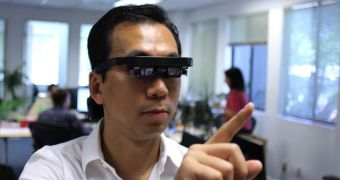We may have had doubts, but augmented reality headsets could become, for the mobile and gadget market, what tablets turned into for the PC industry: an unexpectedly successful product type.
Google would probably love it if its Glass were what the entirety of the augmented reality headset market consisted of for a while.
Sadly, this won't happen. Either that, or the Glass will be undisputed, but not for a very long time.
That is because of things like the Atheer headset, which aims for an even higher peak than Google Glass.
Google glass works by displaying things on the small “lens.” The method is rather restrictive, even if it does lend itself to manipulation by many potential apps.
Atheer's idea is for a set of goggles, albeit an admittedly aesthetically-challenged pair, which don't have to limit the array of useful information in one's peripheral vision (and normal field of view for that matter).
Instead, the Atheer device would create a three-dimensional hologram of a tablet, which can be controlled through gesture tracking (motion control).
Quite an ambition for a startup in Mountain View, California, especially when said startup is surrounded by Google buildings (including the Google Headquarters).
"People don't want to sit in front of a computer anymore, they don't want to be stuck in a room," explains company founder Sleiman Itani.
If the dream ever comes true though, it won't be any time soon. The folks at The Verge saw the first prototype, and deemed it quite unpolished. They weren't even allowed to put it on. A pair of frames were attached to a tripod plugged into the wall, and the software couldn't actually do much of what Atheer promised would eventually be possible.
Whether it's because the Android OS hasn't been optimized for the idea or some other reason, the motion tracking wasn't exactly smooth, and the hardware seemed a bit haphazardly thrown together.

 14 DAY TRIAL //
14 DAY TRIAL //